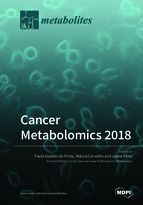Cancer Metabolomics 2018
A special issue of Metabolites (ISSN 2218-1989). This special issue belongs to the section "Endocrinology and Clinical Metabolic Research".
Deadline for manuscript submissions: closed (31 December 2018) | Viewed by 48665
Special Issue Editors
Interests: toxicology; GC-MS; biomarker discovery; toxicometabolomics
Special Issues, Collections and Topics in MDPI journals
Interests: toxicology; drugs of abuse; amphetamines; synthetic cathinones; psychoactive substances; toxicometabolomics; cancer metabolomics; biomarkers; hepatotoxicity; nephrotoxicity; cardiotoxicity; oxidative stress
Special Issues, Collections and Topics in MDPI journals
2. UCIBIO—Applied Molecular Biosciences Unit, Laboratory of Toxicology, Faculty of Pharmacy, University of Porto, 4050-313 Porto, Portugal
Interests: targeted and untargeted metabolomics; GC-MS; NMR; biomarker discovery; cancer
Special Issues, Collections and Topics in MDPI journals
Special Issue Information
Dear Colleagues,
The metabolomics approach, defined as the study of all endogenously-produced low-molecular-weight compounds, appeared as a promising strategy to define new cancer biomarkers. Information obtained from metabolomic data can help to highlight disrupted cellular pathways and, consequently, contribute to the development of new-targeted therapies and the optimization of therapeutics. Therefore, metabolomic research may be more clinically translatable than other omics approaches, since metabolites are closely related to the phenotype and the metabolome is sensitive to many factors. Metabolomics seems promising to identify key metabolic pathways characterizing features of pathological and physiological states. Thus, knowing that tumor metabolism markedly differs from the metabolism of normal cells, the use of metabolomics is ideally suited for biomarker research. Some works have already focused on the application of metabolomic approaches to different cancers, namely lung, breast and liver, using urine, exhaled breath, and blood. In this Special Issue we aim to contribute a more complete understanding of cancer disease by using metabolomics approaches. We would like to invite you for your contribution in this Special Issue dedicated to “Cancer Metabolomics”. This Special Issue will be of a great help for all researchers working in this field.
Dr. Paula Guedes de Pinho
Prof. Dr. Márcia Carvalho
Dr. Joana Pinto
Guest Editors
Manuscript Submission Information
Manuscripts should be submitted online at www.mdpi.com by registering and logging in to this website. Once you are registered, click here to go to the submission form. Manuscripts can be submitted until the deadline. All submissions that pass pre-check are peer-reviewed. Accepted papers will be published continuously in the journal (as soon as accepted) and will be listed together on the special issue website. Research articles, review articles as well as short communications are invited. For planned papers, a title and short abstract (about 100 words) can be sent to the Editorial Office for announcement on this website.
Submitted manuscripts should not have been published previously, nor be under consideration for publication elsewhere (except conference proceedings papers). All manuscripts are thoroughly refereed through a single-blind peer-review process. A guide for authors and other relevant information for submission of manuscripts is available on the Instructions for Authors page. Metabolites is an international peer-reviewed open access monthly journal published by MDPI.
Please visit the Instructions for Authors page before submitting a manuscript. The Article Processing Charge (APC) for publication in this open access journal is 2700 CHF (Swiss Francs). Submitted papers should be well formatted and use good English. Authors may use MDPI's English editing service prior to publication or during author revisions.
Keywords
- untargeted metabolomics (data management, data processing and statistical analysis)
- NMR and MS analytical platforms
- translatability of model systems (cell lines, tumor tissues) to human biofluids
- cancer biomarkers
- validation of biomarkers in biofluids









